A folder in the Lake District
When choosing which folder to use for my holidays, the main
factors which count are the needs for portability, the amount and
type of riding planned, and luggage capacity. The importance of
each factor can vary depending on the type of holiday, and thus
the chosen machine will change as well. I'd never been to the Lake
District before my week there at the end of June 2002, and like my
trip to Skye a couple of months earlier, this was primarily to be
a photographic holiday, based at Lakeland
Photographic Holidays in Braithwaite. The format of their
holidays involves daily trips out from their base, travelling as a
group on three days, and the other three days being left to
individuals to make their own plans, with plenty of suggested
places to visit. Therefore I wasn't planning a large amount of
cycling - just to the station at this end, then by train to
Windermere, and then cycle from there to Braithwaite, repeating
the process in reverse for the return journey, plus perhaps a few
fairly short rides while there. In order to get on trains easily,
and avoid the need to book before hand, portability was quite
important. However. the most important factor in choosing which
bike to use was luggage capacity. As in the case for the Skye
visit, I intended to take a medium format camera, and in view
of its size and weight, and the need to do quite a lot of walking,
a backpack would be the most convenient form of bag for the
camera, and this needed to be carried on the bike - certainly not
on my back while cycling. Although in the end I did not take the
medium format gear and backpack to Skye, this time I stuck to my
original intention, and in both cases this was a crucial feature
in choosing which bike to use.
Although the total quantity of luggage involved is not
particularly large, the size and shape of the back pack makes it
difficult to stow on most bikes, whether they are folders or not;
the Moulton rear rack is ideal, but the lack of portability ruled
out a Moulton. The choice therefore came down to which Brompton to
use, as their luggage carriers are the only ones which will
conveniently accommodate a back pack - slipping the normal bag off
its chassis, and strapping the backpack onto the chassis instead.
For Skye, the original plan had been to use a large backpack on
the front carrier of the T6, using some of the space for clothes
and other non-photographic gear, and using the rear rack-top bag
to carry the remainder, with a tripod strapped on top. When the
medium format system was abandoned in favour of 35mm and digital,
the large Brompton Touring Bag was used at the front to carry
everything except the tripod, which was strapped to the rear
carrier. Although the T6 performed well in Skye, the slightly high
gearing (even with the reduced gear option) and gear range made it
less than ideal, and had it not been for my wish to do more
testing of the bike at the time, I would probably have chosen the
Brompton SP instead. This time, with no duty to do more testing, I
opted for the SP, my main worry being the fact that I would not be
able to use anything other than a Primo tyre on the back, due to
the limited mudguard clearance. For heavier use, possible off road
riding (not planned, but you never know), grip and durability, I
would prefer to use Schwalbes, even though the Primo certainly
provides the lowest rolling resistance. My SP also has an SP rear
rack, which allows the Brompton mounting/bags to be fitted both
front and rear, so the front rack (minus bag) was used to carry
the back pack and cameras, while the rear rack carried a standard
Brompton front bag (if you see what I mean!) plus tripod.
Fitting everything in was quite a tight fit, although as I was
using quite a small photo back pack, and only the standard
Brompton bag, not the touring model, it would certainly have been
possible to get a lot more on the bike. However, with a total
front load of 16 pounds and a rear load of 19 pounds, I did not
want any additional weight to carry, either when riding or when
getting on and off trains. Incidentally, the weights are quoted in
pounds as usual as they were measured on some not very accurate
bathroom scales - I would not place too much reliance on their
absolute accuracy. Using the Brompton meant that fitting and
removing luggage was quite quick and easy, though in the case of
the rear SP carrier, an additional mounting has also to be
removed, which is a bit fiddly. Carrying the luggage is also quite
easy when off the bike, due to the handle provided on the Brompton
carriers, and I could just manage to carry the bike in one hand
and the luggage in the other hand when boarding the train, or
changing platforms.
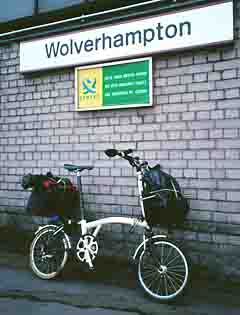 I
don't need to fold to travel from Tipton to Wolverhampton, and it
is easier to move the bike from the bay to the departure platform
while it is still unfolded. The camera bag (Lowepro Micro Trekker
200) is bungeed on to the front rack, and covered by a plastic
sack in anticipation of rain. The standard Brompton bag is mounted
on the SP rear carrier, with the tripod bungeed on the top.
I
don't need to fold to travel from Tipton to Wolverhampton, and it
is easier to move the bike from the bay to the departure platform
while it is still unfolded. The camera bag (Lowepro Micro Trekker
200) is bungeed on to the front rack, and covered by a plastic
sack in anticipation of rain. The standard Brompton bag is mounted
on the SP rear carrier, with the tripod bungeed on the top.
I set out on 22 June, riding to Tipton, catching a train from
there to Wolverhampton, and then boarding a train to Oxenholme.
Regrettably this train was one of the new Voyagers, with very
limited luggage capacity, though this early in the morning it did
not present any problems as it was relatively empty. By the time
we got to Oxenholme we were about 15 minutes late, but I just
managed to make the connection for Windermere.
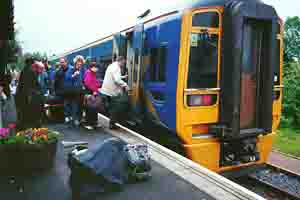 Changing
trains at Oxenholme. The SP is covered with an A to B cover, and
the two bags are on the right.
Changing
trains at Oxenholme. The SP is covered with an A to B cover, and
the two bags are on the right.
By the time I
disembarked, the weather was looking quite threatening, and it was
with some trepidation that I set out on the ride over to
Braithwaite. I'd originally intended this to be quite a leisurely
ride, stopping frequently to take photographs, or explore side
roads if they looked attractive. However, in view of the weather,
I decided to head direct to Braithwaite, although not at any great
speed in view of the load I was carrying. Most of the ride was
along the A591 - a fair amount of traffic, but bearable. Although
the ride could certainly not be described as flat, the hills were
less of a problem than I had feared, and I managed to get up them
all without walking, though I did spend quite a bit of time
grinding (figuratively!) along in bottom gear. There were some
good descents as well, with the V-brakes of the SP providing
plenty of stopping power, though the Primo at the back can lock
very easily, requiring some caution.
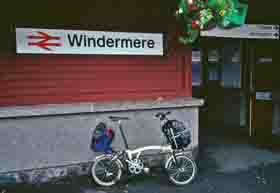 Unfolded
again at Windermere
Unfolded
again at Windermere
To get away from the main road, I diverted around Thirlmere via
a small side road, which was the point at which the threatened
rain materialised. Fortunately the trees provided some shelter,
and by the time I rejoined the main road, the rain had eased.
However, the conditions prompted me to stop in Keswick and
purchase some new boots (the ones I was wearing were the only
footwear I had with me, and they are not longer very good at
keeping out water) and some overtrousers (I dislike cycling in
these, and I did not have any with me).
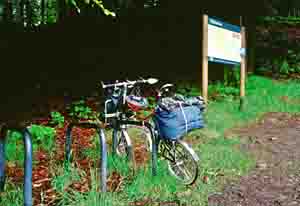 A
brief stop on the side road around Thirlmere - the parking spot is
even provided with bike racks!
A
brief stop on the side road around Thirlmere - the parking spot is
even provided with bike racks!
As I had not made the planned stops, I arrived at Braithwaite
very early, and after unloading my luggage, I went for an
additional ride round Bassenthwaite Lake, keeping an eye open for
the Ospreys which are nesting nearby. The ride along the western
side, on the A66, was marred by the traffic, though it was still
quite pleasant, but the return along the eastern side was much
more pleasant, except that a mysterious creaking and squeaking
noise appeared, mainly, but not exclusively, when pedalling under
load up hills, and which I was not able to trace. I did pass an
Osprey viewing point, but decided not to climb the hill to get to
it. Back at Braithwaite I investigated the noise, but couldn't
find any explanation, and settled for doing some general
lubrication.
Most of the time during the week was spent on photography,
walking and/or using a Land Rover to reach the locations, but on
one day I did take a short ride through Whinlatter Pass, up
towards Cockermouth and then back along the western side of
Bassenthwaite Lake. The climb up to the pass from Braithwaite was
challenging, even with reduced luggage, and I have to admit that I
pushed for about 50 metres. Although the mechanical noises still
seemed to be present intermittently, they were getting now worse,
and although I couldn't identify the source, my suspicions centred
on the rubber suspension block mounting and the plastic end cap
which rubs on the seat tube - irritating, but not critical. The
only other occasion during the week when I used the bike was on
our outing to Watendlath - we went up there in the Land Rover, but
I took the SP in the back, folded up. After a fairly strenuous
walk to Dock Tarn and back, the SP was unloaded and I rode back,
making a circuit of Derwent Water in the process. The steep
descent from Watendlath was a good test of the V-brakes, which
performed admirably, though the ease with which the rear wheel
could be locked encouraged a cautious approach.
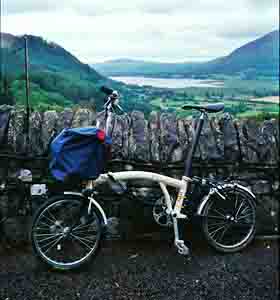 A
view of Bassenthwaite Lake during the climb to Whinlater Pass. The
bike is now relatively lightly loaded, with a digital camera and
tripod (and lunch) in the standard Brompton bag, now transferred
to the front.
A
view of Bassenthwaite Lake during the climb to Whinlater Pass. The
bike is now relatively lightly loaded, with a digital camera and
tripod (and lunch) in the standard Brompton bag, now transferred
to the front.
Taking a break later the same day - Murphy's Law came into
effect, while preparing to take the picture, the Post Office van
arrived to empty the box, so I had to move the bike.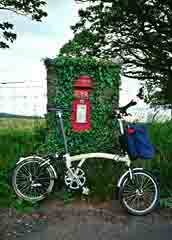
All too soon the holiday was at an end, and the bike had to be
loaded again with luggage for the return journey on 29th June. I
was not looking forward to the hill out of Keswick, and it did
reduce me to walking for about 50 metres, but otherwise I managed
to ride all the rest of the hills. Somehow I missed the side road
around Thirlmere, so this time I stayed on the main road all the
way. Unfortunately just before Windermere I had a puncture. I'd
been a bit concerned about using a Primo on the rear, but my
puncture was actually in the Brompton (Kevlar version) front tyre,
caused by glass. Repairing it was fairly easy, and the advantage
of the easily removed luggage system of the Brompton was
demonstrated again. The rest of the return journey was relatively
uneventful, though on a much fuller Voyager there was no luggage
space left, and I spent the entire journey standing in the lobby
with the SP and luggage. The train from Wolverhampton to Tipton
turned out to be even less pleasant - there were plenty of seats,
but a gang of yobs decided that a lone cyclist was a good target,
and made it a miserable experience.
Overall, this was a most enjoyable week, and, despite poor
weather on the way up there and for the first day, things
improved, and the conditions were quite good. The Brompton SP
proved admirably suited to this type of holiday - portability was
great, luggage capacity quite adequate, and the riding qualities
were more than adequate. Apart from the occasional mechanical
noises and the punctures, there were no problems, and a bit of
attention to the rear suspension block now seems to have
eliminated the problem. The lighter weight of the SP, with the
improved brakes and gearing, certainly made for more enjoyable
riding than when I used the T6 on Skye, but that's not intended as
a serious criticism of the T6. I would have liked the number and
range of gears of some of my other folders, but the portability
and luggage capacity advantages of the Brompton SP certainly made
it the right choice for me on this occasion. Finally, if you are
looking for a good photographic holiday, I can certainly recommend
Lakeland
Photographic Holidays - the trouble is, they are so good that
they are already fully booked up for the remainder of 2002!
Folding Society Home Page
| Event Reports Page
Copyright (C)2002 Ferrets Anonymous
URL: http://www.foldsoc.co.uk/lakes02.html
Last updated: 6 July 2002
 I
don't need to fold to travel from Tipton to Wolverhampton, and it
is easier to move the bike from the bay to the departure platform
while it is still unfolded. The camera bag (Lowepro Micro Trekker
200) is bungeed on to the front rack, and covered by a plastic
sack in anticipation of rain. The standard Brompton bag is mounted
on the SP rear carrier, with the tripod bungeed on the top.
I
don't need to fold to travel from Tipton to Wolverhampton, and it
is easier to move the bike from the bay to the departure platform
while it is still unfolded. The camera bag (Lowepro Micro Trekker
200) is bungeed on to the front rack, and covered by a plastic
sack in anticipation of rain. The standard Brompton bag is mounted
on the SP rear carrier, with the tripod bungeed on the top. Changing
trains at Oxenholme. The SP is covered with an A to B cover, and
the two bags are on the right.
Changing
trains at Oxenholme. The SP is covered with an A to B cover, and
the two bags are on the right. Unfolded
again at Windermere
Unfolded
again at Windermere A
brief stop on the side road around Thirlmere - the parking spot is
even provided with bike racks!
A
brief stop on the side road around Thirlmere - the parking spot is
even provided with bike racks! A
view of Bassenthwaite Lake during the climb to Whinlater Pass. The
bike is now relatively lightly loaded, with a digital camera and
tripod (and lunch) in the standard Brompton bag, now transferred
to the front.
A
view of Bassenthwaite Lake during the climb to Whinlater Pass. The
bike is now relatively lightly loaded, with a digital camera and
tripod (and lunch) in the standard Brompton bag, now transferred
to the front.